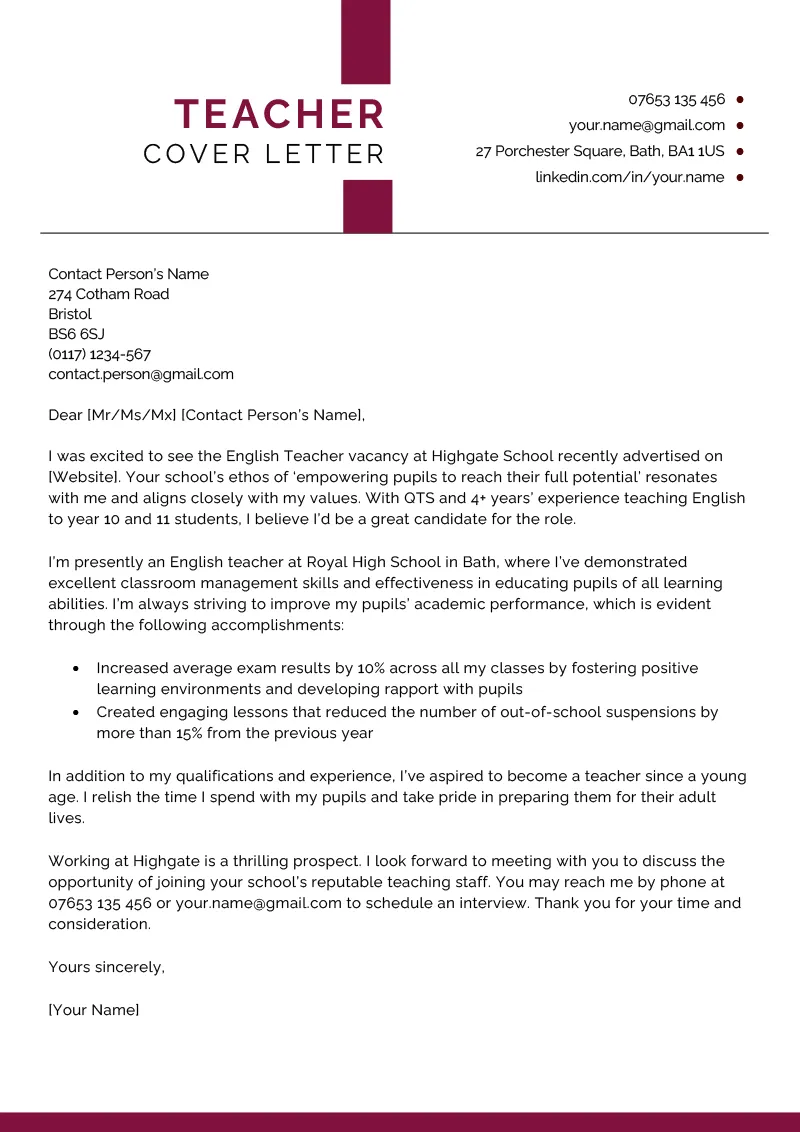Crafting a Compelling Teaching Cover Letter
A well-crafted teaching cover letter is your first opportunity to make a positive impression on a potential employer. It serves as a crucial introduction, allowing you to showcase your personality, skills, and experience in a way that a resume alone cannot. A compelling cover letter can set you apart from other applicants, demonstrating your passion for teaching and your understanding of the specific requirements of the position. By investing time and effort in creating a strong cover letter, you significantly increase your chances of securing an interview and, ultimately, landing your dream teaching job. Remember, the cover letter is your chance to tell your story and explain why you are the best fit for the role and the school’s culture.
Understanding the Purpose of a Cover Letter
The primary purpose of a teaching cover letter is to introduce yourself and your qualifications to a hiring committee or principal. It is not simply a reiteration of your resume; rather, it’s an opportunity to provide context, explain your teaching philosophy, and highlight how your skills and experiences align with the specific needs of the school and the position. It should demonstrate your enthusiasm for the role and your genuine interest in the school’s mission and values. Think of it as a persuasive essay, making the case for why you deserve an interview. It should also showcase your communication skills. A well-written letter indicates your ability to articulate your thoughts clearly and concisely, a vital skill in the teaching profession.
Highlighting Your Qualifications
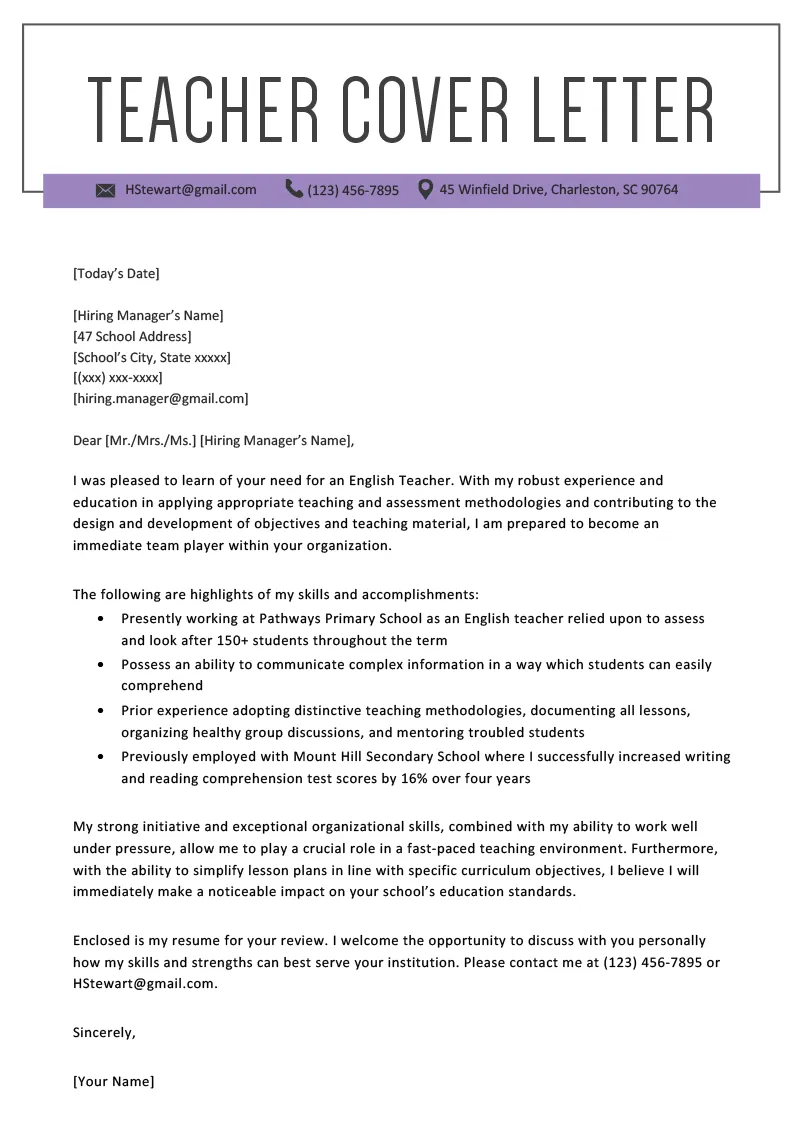
Your teaching qualifications are the foundation of your application. Be sure to clearly state your teaching credentials, including your degree(s), certifications, and any special endorsements. If you are a recent graduate, emphasize your student teaching experience, including the grade levels and subjects you taught. If you have years of experience, focus on your ongoing professional development, any leadership roles you’ve held, and any specialized training you have completed. Quantify your qualifications whenever possible. For example, state the number of years you have been teaching, the number of students you have successfully taught, or the percentage of students who have improved their test scores under your guidance. This helps demonstrate your value and impact.
Showcasing Your Experience
Your teaching experience is a core element of your cover letter. Go beyond simply listing your previous positions; provide specific examples of your accomplishments and how you have positively impacted student learning. Describe the teaching methodologies you have used and the results you have achieved. Discuss any challenges you faced and how you overcame them. For example, you might describe how you developed a new curriculum, implemented innovative teaching strategies, or successfully managed a diverse classroom. Focus on how your experience has prepared you for this specific role. Make sure to align your experience with the requirements and expectations outlined in the job description, emphasizing how your skills and experience make you the ideal candidate for the position.
Tailoring Your Cover Letter
One of the most crucial aspects of a successful teaching cover letter is tailoring it to each specific job and school. Avoid using a generic template. Instead, carefully review the job description and identify the key skills, qualifications, and values that the school is seeking. Then, customize your letter to address these specific requirements. Highlight the experiences, skills, and achievements that are most relevant to the position. Show that you understand the school’s mission, values, and student population. This level of personalization demonstrates your genuine interest in the role and increases your chances of making a strong impression on the hiring committee. Address the specific needs and goals of the school to show how you can contribute to their success.
Researching the School and Position
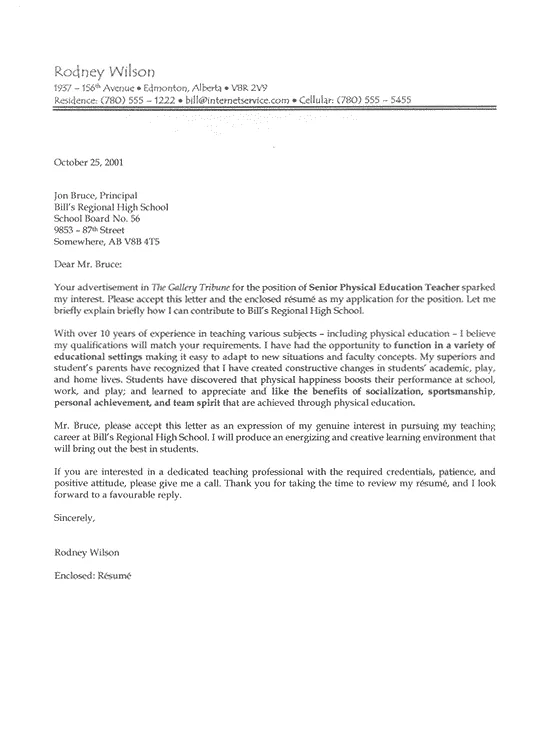
Before you start writing your cover letter, research the school and the specific teaching position. Visit the school’s website to learn about its mission, values, and programs. Understand the school’s demographics, academic performance, and extracurricular activities. If possible, read any recent news articles or publications about the school. This will enable you to tailor your letter to align with the school’s unique culture and priorities. When you understand the needs and priorities of the school, you can then align your letter to address these. Refer to the specific requirements and qualifications outlined in the job description. This will help you demonstrate your understanding of the position and your ability to meet its demands.
Addressing the Hiring Manager
Whenever possible, address your cover letter to a specific person, such as the principal or a member of the hiring committee. This shows that you have taken the time to research the school and position and that you are genuinely interested in the role. If you cannot find a specific name, you can use a general salutation like “Dear Hiring Committee” or “Dear Principal.” Avoid generic greetings like “To Whom It May Concern.” Using a specific name can make your cover letter feel more personal and increase the likelihood of it being read carefully. If you can find the name of the hiring manager, make sure to spell it correctly. Check the school website or LinkedIn to verify the correct spelling and title.
Opening with Impact
The opening of your cover letter is crucial for grabbing the reader’s attention. Start with a strong statement that immediately captures their interest. You can highlight your enthusiasm for the position, mention a relevant achievement, or briefly state your teaching philosophy. Avoid clichés and generic opening lines. Instead, tailor your opening to the specific school and position. For example, you might mention a recent school initiative or an innovative program. Consider starting with a brief anecdote or a compelling statement that reflects your passion for teaching. The goal is to hook the reader and make them want to continue reading.
Demonstrating Your Teaching Philosophy
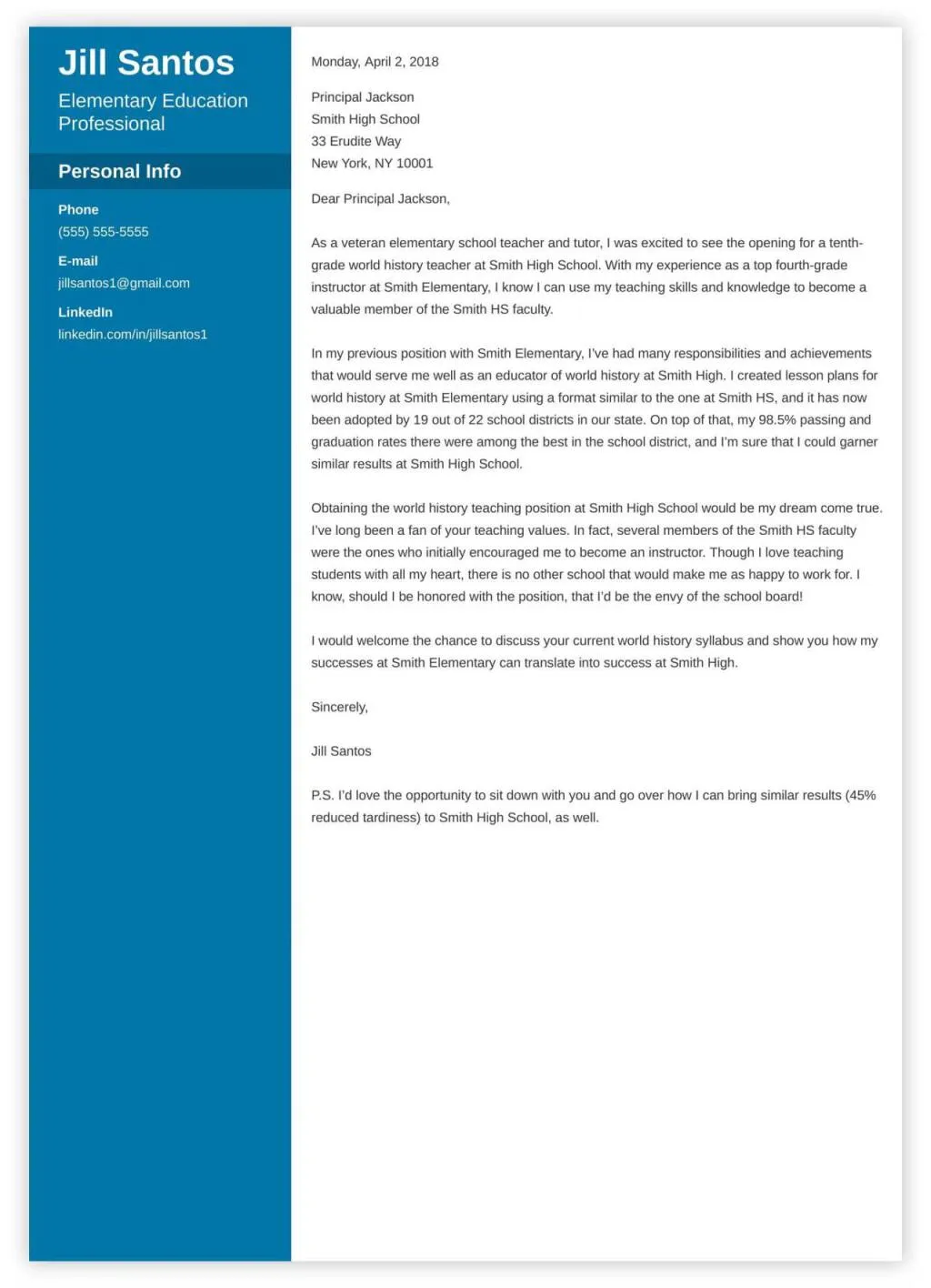
Your teaching philosophy is a critical element of your cover letter, giving the hiring committee insights into your approach to education. Clearly articulate your beliefs about teaching and learning. Include examples of how you create a positive and engaging classroom environment. Explain your strategies for differentiating instruction to meet the needs of diverse learners. Demonstrate your commitment to fostering student growth and development. Briefly describe how you motivate students, manage the classroom, and promote a love of learning. Connect your philosophy to the specific requirements of the school and the position to show how you can contribute to its educational goals.
Emphasizing Your Achievements
Use your cover letter to highlight your accomplishments, not just list your responsibilities. Provide concrete examples of how you have made a positive impact on student learning. Quantify your achievements whenever possible. For example, state the percentage increase in test scores, the number of students you have helped improve, or the specific projects you have led. Show that you have a track record of success and are committed to student achievement. Mention any awards or recognitions you have received. Highlight the skills and experiences that make you a strong candidate for the position. Showcase your value to the school by focusing on what you’ve achieved and how you can contribute to their success.
Quantifying Your Accomplishments
Use data and numbers to demonstrate your accomplishments. Instead of saying, “I improved student performance,” say, “I increased student test scores by 15% in one year.” Quantifying your accomplishments provides concrete evidence of your skills and abilities. For example, you could mention the number of students who participated in your extracurricular activities, the number of grants you have secured, or the percentage of students who completed your assignments. Using numbers makes your accomplishments more impactful and shows that you understand the importance of data-driven results. Always provide context and explain the significance of your numbers.
Closing with a Strong Call to Action
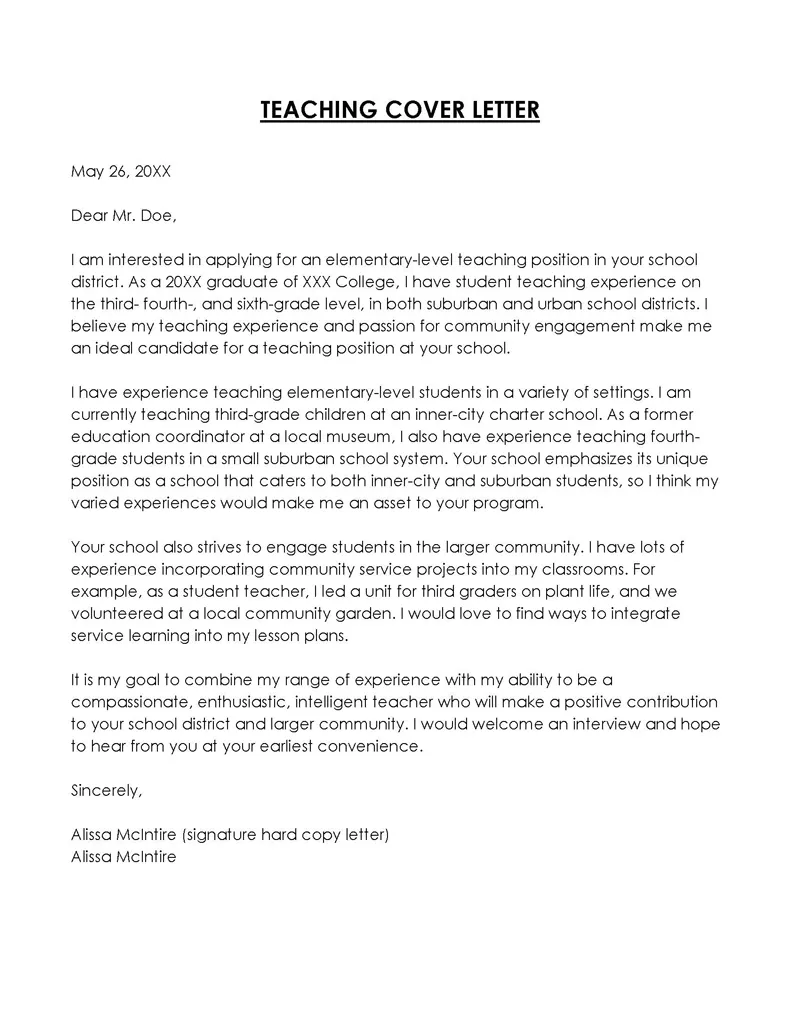
End your cover letter with a strong call to action. Express your enthusiasm for the position and reiterate your interest in the school. State that you are eager to learn more about the opportunity and are available for an interview at their earliest convenience. Thank the reader for their time and consideration. Providing your contact information again helps facilitate a quick response. Make it easy for the hiring committee to contact you. A clear call to action shows that you are proactive and motivated and allows you to end on a positive note.
Proofreading and Editing Your Letter
Proofreading and editing your cover letter is essential for ensuring that it is polished and professional. Carefully review your letter for any grammatical errors, spelling mistakes, and typos. Ask a friend, colleague, or mentor to review your letter for you. They may catch errors that you have missed. Make sure that your language is clear, concise, and easy to understand. Ensure the formatting is consistent and visually appealing. Proofread again and again. A well-written and error-free cover letter demonstrates your attention to detail and your commitment to excellence.
Ensuring Accuracy and Professionalism
Ensure your cover letter is accurate and professional. Double-check all the information you provide, including dates, names, and contact details. Use a professional font and formatting. Maintain a formal tone throughout the letter. Avoid using slang, jargon, or overly casual language. Make sure your letter is easy to read and visually appealing. Ensure that your cover letter reflects your professionalism and attention to detail, both of which are crucial qualities for a teacher. Your cover letter is a reflection of you as a teacher, so making a great impression is important.
